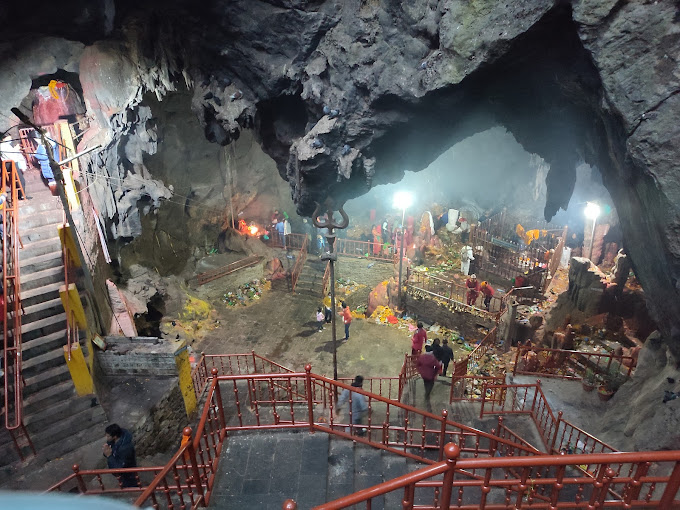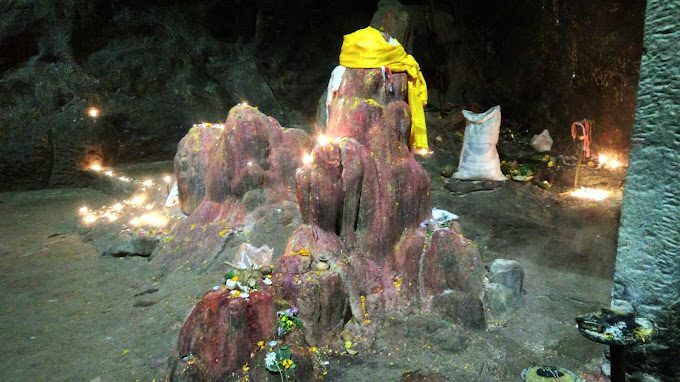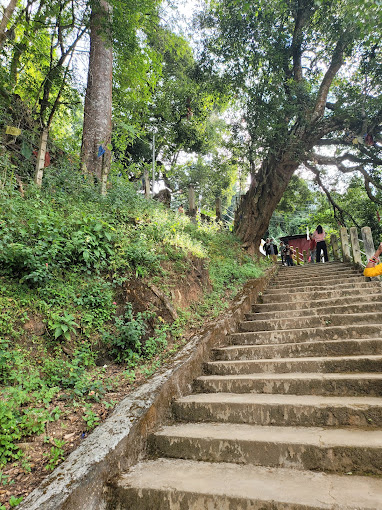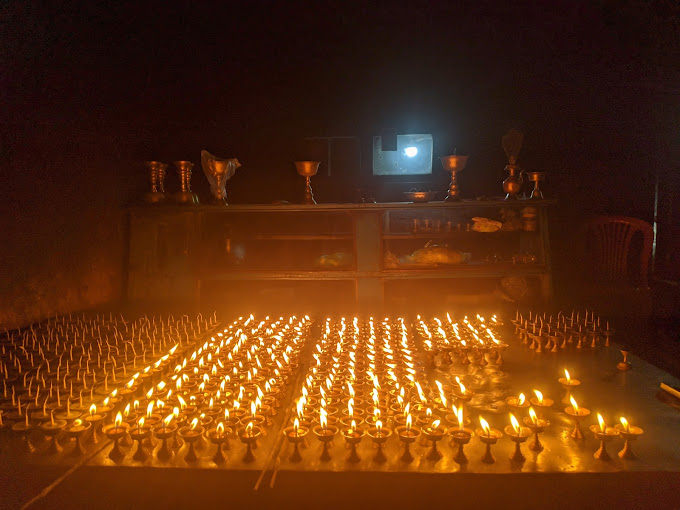 Halesi Mahadev also known as Haleshwor Mahadev ( Maratika Cave) , is a sacred cave temple located in Khotang district of Nepal. The cave is believed to be the abode of Lord Shiva and is visited by thousands of devotees each year. The temple is situated in a secluded area, surrounded by lush green hills, and can only be reached by a steep climb of around 1,300 steps.
Halesi Mahadev also known as Haleshwor Mahadev ( Maratika Cave) , is a sacred cave temple located in Khotang district of Nepal. The cave is believed to be the abode of Lord Shiva and is visited by thousands of devotees each year. The temple is situated in a secluded area, surrounded by lush green hills, and can only be reached by a steep climb of around 1,300 steps.

The Halesi Mahadev is said to have been discovered by a cowherd in the 14th century. According to legend, the cowherd was looking for a lost cow when he stumbled upon the cave. Inside, he found a natural shivlinga, which he believed to be the representation of Lord Shiva. The cave quickly became a pilgrimage site, and a temple was built around it.

The caves is a complex of three caves, each representing the three eyes of Lord Shiva. The main cave houses the shivlinga, which is considered to be one of the most sacred in Nepal. The cave is also adorned with intricate carvings and sculptures, depicting scenes from Hindu mythology.

The temple is a popular pilgrimage site, especially during the festival of Maha Shivaratri, when thousands of devotees flock to the temple to offer prayers and perform puja. The temple is also considered to be an important site for the Kirant community, who believe that Lord Shiva has a special connection with their culture.
The highlight of Maratika Cave
The Maratika Cave holds several highlights and significant aspects that attract visitors, especially Buddhist practitioners and spiritual seekers.
Guru Rinpoche’s Meditation:
Maratika Cave is renowned as the place where Guru Rinpoche, also known as Padmasambhava, achieved immortality or ‘mahamudra’ through intensive meditation. According to legend, Guru Rinpoche spent several months meditating in the cave and attained enlightenment, symbolizing the realization of the highest spiritual truth.
Symbol of Longevity and Life Preservation:
Maratika Cave is associated with the practice of longevity and the preservation of life. It is believed that visiting the cave, performing rituals, and reciting specific mantras can help extend one’s lifespan and bring about positive health benefits. Many Buddhist practitioners visit the cave with the aspiration of enhancing their well-being and prolonging their lives.
Relics and Sacred Objects:
The cave houses various relics and sacred objects related to Guru Rinpoche. These include statues, prayer flags, ritual items, and images that hold immense spiritual significance for devotees. These relics serve as a focal point for meditation, contemplation, and spiritual connection.
Pilgrimage Site:
Maratika Cave is considered a significant pilgrimage site for Buddhists. It attracts devotees from Nepal, Tibet, India, and other parts of the world who undertake arduous journeys to visit and pay homage to the cave. The pilgrimage to Maratika Cave is seen as a profound spiritual endeavor that allows individuals to deepen their practice, seek blessings, and purify their minds.
Natural Beauty:
The cave is nestled amidst picturesque surroundings, offering a serene and tranquil environment for meditation and contemplation. Surrounded by lush greenery, rolling hills, and the sound of flowing streams, Maratika Cave provides a conducive atmosphere for spiritual retreats and self-reflection.
These highlights collectively make Maratika Cave a revered and sacred destination for Buddhist practitioners and those seeking spiritual growth, enlightenment, and the preservation of life.
Attractions of the Halesi Mahadev Temple
Cave Temple: The temple is located inside a large cave that is believed to have been used by Hindu saints for meditation and spiritual practices. The cave is considered to be sacred, and many visitors come here to seek blessings and perform religious rituals.
Hindu Deities: The temple is dedicated to Lord Shiva, and features several shrines and sculptures of the deity and other Hindu gods and goddesses.
Spiritual Significance: Halesi Mahadev Temple is considered to be one of the most important spiritual sites in Nepal, and is said to have the power to grant wishes and cure ailments.
Scenic Location: The temple is located in a picturesque valley surrounded by rolling hills and lush forests, making it a beautiful and peaceful place to visit.
Cultural Heritage: The temple is a testament to the rich cultural and religious heritage of Nepal, and is a must-visit destination for anyone interested in learning more about Hinduism and the local culture.
Festivals and Celebrations: The temple is the site of several Hindu festivals and celebrations throughout the year, including the annual Halesi Mahadev Jatra, which is attended by thousands of pilgrims from across Nepal and India.
Halesi Mahadev Temple is a fascinating and spiritually significant destination that offers visitors a chance to experience the rich cultural and religious heritage of Nepal.




